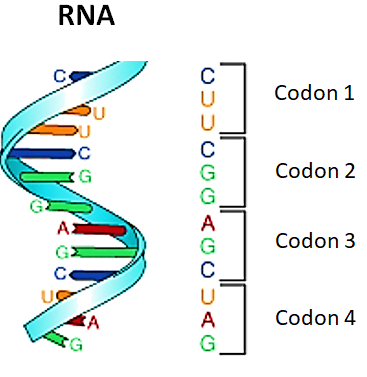
What is a triplet codon?
(a)Fixed
(b)Degenerate
(c)Ambiguous
(d)Non-wobbly
Answer
501k+ views
Hint: Triplet codon is a sequence of three DNA or RNA nucleotides that code for a specific amino acid. Some amino acids are coded by more than one base triplet or codon. The full set of codons is called the genetic code.
Complete answer :Degeneracy of codons can be explained as the redundancy of the genetic code. It is shown as the multiplicity of three-base pair codon combinations that code for a particular amino acid. The degeneracy of the genetic code accounts for the existence of synonymous mutations.
Additional information:
Characteristics of the genetic code:
>Triplet nature: Codon is a set of three nucleotides that code for a particular amino acid. There are 64 codons used to code all 20 amino acids.
>Degeneracy: The triplet codon is degenerate means the same amino acid is coded by more than one base triplet. For example, GAA and GAG both specify glutamic acid and exhibit redundancy.
>Non-Overlapping: The genetic code is non overlapping means the same code is not used for two different codons. In other words, the adjacent codons do not overlap.
>Commaless: The genetic codes are comma free. There are no punctuations at the beginning and the end of the codon. In mRNA, the codon is read in a continuous fashion.
>Non-ambiguity: Genetic codes are specific i.e. one codon codes for only one amino acid.
>Start codon: AUG and GUG codes for Methionine (Met) and Valine (Val), respectively. They perform dual functions and also act as initiator codon.
>Stop codon: There are 3 codons that do not code for any amino acids hence they perform stop codon. They include UAG, UAA, UGA called nonsense codons.
So, the correct answer is ‘degenerate’.
Note: Codons are universal in nature such as from bacteria to human UUU is a code for Phenylalanine (phe).
-The genetic code is always read in a fixed direction, i.e., in the 5′ → 3′ direction.
-The nature of a codon was first revealed by Marshall Nirenberg and Heinrich J. Matthaei in 1961.

Complete answer :Degeneracy of codons can be explained as the redundancy of the genetic code. It is shown as the multiplicity of three-base pair codon combinations that code for a particular amino acid. The degeneracy of the genetic code accounts for the existence of synonymous mutations.
Additional information:
Characteristics of the genetic code:
>Triplet nature: Codon is a set of three nucleotides that code for a particular amino acid. There are 64 codons used to code all 20 amino acids.
>Degeneracy: The triplet codon is degenerate means the same amino acid is coded by more than one base triplet. For example, GAA and GAG both specify glutamic acid and exhibit redundancy.
>Non-Overlapping: The genetic code is non overlapping means the same code is not used for two different codons. In other words, the adjacent codons do not overlap.
>Commaless: The genetic codes are comma free. There are no punctuations at the beginning and the end of the codon. In mRNA, the codon is read in a continuous fashion.
>Non-ambiguity: Genetic codes are specific i.e. one codon codes for only one amino acid.
>Start codon: AUG and GUG codes for Methionine (Met) and Valine (Val), respectively. They perform dual functions and also act as initiator codon.
>Stop codon: There are 3 codons that do not code for any amino acids hence they perform stop codon. They include UAG, UAA, UGA called nonsense codons.
So, the correct answer is ‘degenerate’.
Note: Codons are universal in nature such as from bacteria to human UUU is a code for Phenylalanine (phe).
-The genetic code is always read in a fixed direction, i.e., in the 5′ → 3′ direction.
-The nature of a codon was first revealed by Marshall Nirenberg and Heinrich J. Matthaei in 1961.

Recently Updated Pages
Master Class 12 Business Studies: Engaging Questions & Answers for Success

Master Class 12 English: Engaging Questions & Answers for Success

Master Class 12 Social Science: Engaging Questions & Answers for Success

Master Class 12 Chemistry: Engaging Questions & Answers for Success

Class 12 Question and Answer - Your Ultimate Solutions Guide

Master Class 12 Economics: Engaging Questions & Answers for Success

Trending doubts
Give 10 examples of unisexual and bisexual flowers

Draw a labelled sketch of the human eye class 12 physics CBSE

Differentiate between homogeneous and heterogeneous class 12 chemistry CBSE

Write a short note on Franklands reaction class 12 chemistry CBSE

Differentiate between insitu conservation and exsitu class 12 biology CBSE

What are the major means of transport Explain each class 12 social science CBSE




